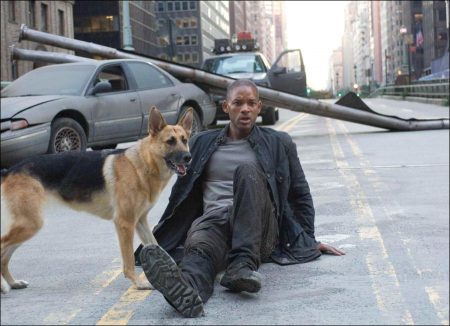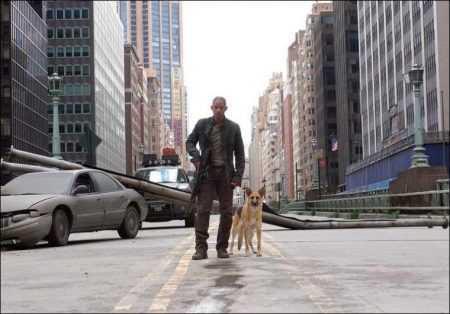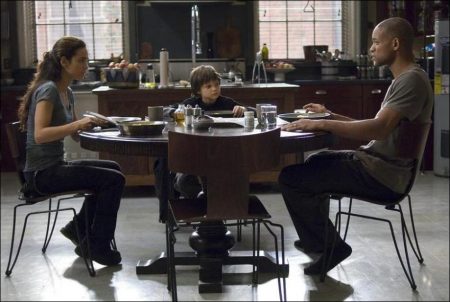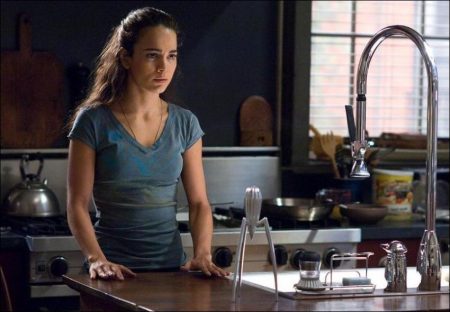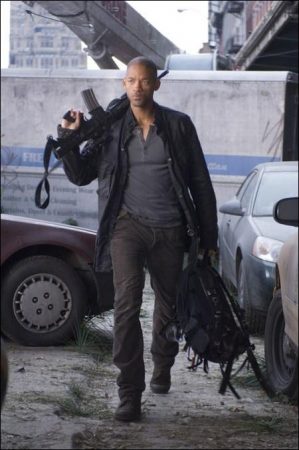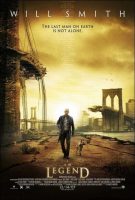Tagline: The last man on earth is not alone.
“My name is Robert Neville. I am a survivor living in New York City. If there is anybody out there…anybody. Please. You are not alone.”
Robert Neville (Will Smith) is a brilliant scientist, but even he could not contain the terrible virus that was unstoppable, incurable… and manmade. Somehow immune, Neville is now the last human survivor in what is left of New York City… and maybe the world. But he is not alone. He is surrounded by “the Infected”-victims of the plague who have mutated into carnivorous beings who can only exist in the dark and who will devour or infect anyone or anything in their path.
For three years, Neville has spent his days scavenging for food and supplies and faithfully sending out radio messages, desperate to find any other survivors who might be out there. All the while, the Infected lurk in the shadows, watching Neville’s every move, waiting for him to make a fatal mistake. Perhaps mankind’s last, best hope, Neville is driven by only one remaining mission: to find a way to reverse the effects of the virus using his own immune blood. But his blood is also what The Infected hunt, and Neville knows he is outnumbered and quickly running out of time.
I Am Legend is a 2007 American post-apocalyptic science fiction horror film based on the novel of the same name, directed by Francis Lawrence and starring Will Smith, who plays US Army virologist Robert Neville. The story is set in New York City after a virus, which was originally created to cure cancer, has wiped out most of mankind, leaving Neville as the last human in New York, other than nocturnal mutants. Neville is immune to the virus and he works to develop a cure while defending himself against the hostile mutants.
The film was released on December 14, 2007, in the United States and Canada, and opened to the largest ever box office (not adjusted for inflation) for a non-Christmas film released in the U.S. in December. The film was the seventh-highest grossing film of 2007, earning $256 million domestically and $329 million internationally, for a total of $585 million.
About the Production
My name is Robert Neville… Will Smith, the star of such films as “I, Robot,” “Independence Day” and “Men in Black,” is no stranger to science fiction and has long had an affinity for Richard Matheson’s timeless novel I Am Legend. “There are so many genres within it: horror, science fiction, and this wonderful character piece,” the actor says. “The psychology of being the last man on Earth has always intrigued me. The physical, emotional and spiritual lengths that Robert Neville has to go to just to survive present a beautiful opportunity to tell a universal story about the nature of humanity.”
Francis Lawrence, the director of the new science fiction action thriller based on Matheson’s tale, adds, “The idea of a man surviving cut off and alone in a modern urban environment was fascinating to me and one that I wanted to explore on film. `I Am Legend’ is the quintessential story of one man against the world, which is one reason why it continues to capture people’s imaginations more than half a century after it was first written.”
Complex and provocative, Matheson’s 1954 novel, widely recognized as a primer for the modern-day horror-science fiction genre, has influenced generations, inspired countless imitators and spawned two prior movie adaptations: 1964’s “The Last Man on Earth,” starring Vincent Price, and 1971’s “The Omega Man,” starring Charlton Heston.
Screenwriter/producer Akiva Goldsman, the Oscar-winning screenwriter of “A Beautiful Mind” and a self-proclaimed lifelong fan of the author, says that he relished the opportunity to reimagine “I Am Legend” for the screen. “Richard Matheson is like a god to those of us who are science fiction geeks. There is a tradition within serious science fiction of reaching deeply into the roots of character to explore powerful themes-the idea of using science fiction as allegory. This film really grows from that ethic.”
Goldsman worked from the initial adaptation of Matheson’s seminal novel by Mark Protosevich, which had been one of the most coveted scripts in recent years. Protosevich relates, “This has been a passion project of mine for over a decade now, and I was thrilled to finally see it being made, especially with this level of talent on both sides of the camera.”
“I Am Legend” tells a story almost entirely centered around a man living a solitary existence. The filmmakers knew the demanding role would require a high-caliber actor, and when they learned that Will Smith had an interest in the role, the main element of the project clicked into place. Smith, along with producer James Lassiter, his partner at Overbrook Entertainment, had been keeping tabs on the project’s development over the years. He regarded playing the role of Robert Neville-a character who occupies the screen virtually alone for much of the film-as both a challenge and an opportunity.
Goldsman remarks, “As a writer, I believe greatly in the ability of the written word to describe and generate a character. But, ultimately, what is equally important is the ability to convey what is unspoken. Will is such a fine actor; he delivered an extraordinary performance wherein many of his thoughts and emotions are conveyed through his expressions and behavior.”
Smith had to rely on other forms of expression to portray the emotional range of Neville’s journey. “The process was very different for me because it’s all behavior. It’s just an incredible exercise to not be able to talk yet have to communicate,” he offers. “To have to figure out how to communicate without words-for me, it’s the center of what acting is. When you just go quiet for a while, you start to discover a whole range of things about your character and yourself. It’s a fascinating place to explore, both artistically and psychologically.”
Making his first film with Smith, Francis Lawrence found a sound anchor for the emotional story arc at the heart of the adventure. “What’s fantastic about Will is that he has such a warmth and charisma to him,” notes the director. “He brings so many dimensions to his role and takes you along with him at every moment. There’s real sympathy for him, you’re scared for him, you laugh with him and you cry with him…and all those layers exist at once in his performance. Most importantly in this role, he is able to convey everything he is going through, both physically and emotionally, often without any dialogue at all.”
Perhaps the greatest compliment to Smith came from the man who first created the character of Robert Neville. “I think Will Smith is the perfect person to portray Robert Neville,” author Richard Matheson states. “I’ve seen almost every film he has made, and he is always totally convincing in whatever role he is playing. In this story, his character is key and, therefore, he is key.”
I am a survivor living in New York City… I can provide food.
I can provide shelter. I can provide security.
At the core of “I Am Legend” is one man’s struggle to survive against seemingly insurmountable odds: alone and surrounded by the Infected-monstrous beings who kill without thought or rationale. His situation is made worse by the knowledge that it was instigated by his own kind. The roots of the pandemic that wiped out civilization and left Neville isolated and in a constant state of peril emerged from what was initially hailed as a breakthrough in modern medicine: a man-made retrofitted virus developed to combat one of history’s most deadly diseases, cancer. But the initial success of the retrovirus was soon met with unimaginable repercussions.
Neville, a military virologist based in Manhattan, spearheaded the government’s attempt to find a vaccine to combat the pandemic. But in spite of their efforts, the virus went airborne and the city was subsequently locked down with only the uninfected allowed to evacuate. In the resulting panic, Neville witnesses the tragic deaths of his wife Zoë (Salli Richardson) and daughter Marley, played by 7-year-old Willow Smith, who makes her feature debut opposite her real-life father.
Those of the Infected who didn’t succumb to the virus were perhaps dealt a worse fate: their ravaged metabolism transforming them into creatures who dwell in the darkness of the city’s vast underground, emerging from the shadows, driven by a singular, primal hunger.
In the aftermath of the catastrophe, Neville is also driven, but his need is to find a cure for the cataclysmic affliction. Somehow immune to the virus, he knows he has two weapons at his disposal-his scientific training and his own blood. “Neville knows these beings are infected with a virus that is a mutation of what was created in a lab,” Smith relates. “Now he has been put in this position of being a lone survivor after being the one who, in his mind, couldn’t save mankind.”
Neville’s experience as a military scientist also defines the way he chooses to live his life in the abandoned city. His approach is highly regimented, from the exhaustive physical conditioning to the setting of the daily alarm marking the exact time of sundown. “Neville is a very disciplined man,” comments Lawrence. “It’s what keeps him as sane as possible in a situation like this. His choices are extreme, but if that routine were to start to break down, it’s very possible that he would fall apart.”
With only the companionship of his dog, Sam, Neville struggles to keep himself one step ahead of the Infected. By day, he and Sam subsist by scavenging for supplies, working in the lab and broadcasting daily radio messages in hopes of finding other survivors. By night, they barricade themselves in a reinforced brownstone monitoring the Infected as they hunt and forage through the city streets, sniffing out any hint of prey.
As Neville marks time with various activities and duties, he also experiences a certain freedom. Whether joyriding through the streets in his Shelby, working on his golf swing atop a fighter jet, decorating his impregnable brownstone with priceless treasures, or cataloguing the city’s vast food, gas and medical supplies with an intricate mapping system, Neville has free reign of the city’s vast resources.
In the surrealism of the new New York, iconic places that were once centers of commerce, art and entertainment have now become Neville’s personal playground, hunting ground and garden.
“When you’re the last man alone in New York, there’s some fun to be had, albeit lonely fun,” says Lawrence. “We see these elements that seem so important to the world we live in, but after the pandemic happens and the world as we know it goes away, things that we spend so much time, energy and billions of dollars building are just sitting there rotting. They’re absolutely useless.”
“Neville has access to virtually anything,” comments Smith. “There’s a medical supply; he knows where canned goods are, where gasoline storage is. He uses the entire city as his home. And there’s nothing like standing up on top of an aircraft carrier with a golf club.”
It was not all fun and games, however. Sprinting down abandoned streets, hanging upside down twenty feet in the air, maneuvering a speeding Ford Mustang, leaping atop rusted vehicles and fighting stuntmen garbed in motion capture visual effect suits to portray the Infected are only a sampling of what Smith endured to accomplish the film’s heart-pounding action scenes.
To choreograph these sequences, the filmmakers brought in veteran stunt coordinator Vic Armstrong and his accomplished stunt unit. Armstrong’s 40-year career most recently includes such action-centered films as “Mission Impossible III,” “War of the Worlds” and “Die Another Day.”
Knowing Smith’s ease at injecting physicality into his performances-whether fashioning the building blocks of a character or participating in key action sequences- the filmmakers welcomed the actor’s hands-on approach to stuntwork. Months prior to filming, Smith began a nutrition and fitness program that yielded a leaner, trimmer physique. Working with longtime physical fitness trainer Darrell Foster, who years earlier had transformed him for his Academy Award-nominated turn in “Ali,” Smith dropped 20 pounds on a regimen every bit as strenuous as Neville’s own. Cites Foster, “We put him in desperate straits-high-altitude training for oxygen deprivation, heat, cold, humidity, low-caloric intake and many other adverse conditions. It helped him develop the mental aspects of his character as well as the physical.”
By contrast, training with military and weapons consultant Sam Glen to handle Neville’s specially modified rifle was far easier on the actor, who had handled firearms on previous films.
If there is anybody out there. Please. You are not alone…
Smith spends the most time onscreen opposite Neville’s constant companion, a dog named Sam, portrayed in the film, primarily, by a three-year-old German shepherd named Abbey. Head animal trainer Steve Berens, whose motion picture credits include “Click” and “The Mask,” understood that expectations were high for him to elicit a full range of emotions from his charge. Confidence in Abbey’s innate ability coupled with a specific training regimen shaped the trainer’s approach to eliciting a strong performance from his canine actor.
“It all lies in how you prepare the animal,” Berens explains. “You train them day after day so that when they get on set for that particular shot, they understand and are committed to the whole situation; they’re in the game. We know it’s work, but the whole idea is to make it fun. If you do it correctly, with love and positive reinforcement, they truly enjoy it. It’s about creating a camaraderie with your dog and then passing that on to the actor. And Will was terrific with Abbey. They really developed their own bond.”
Everything about Neville’s existence changes when his daily broadcast is finally heard by other survivors: a woman named Anna, played by Alice Braga (pronounced A¬lee-cee), and a child, Ethan, played by Charlie Tahan. The two turn up unexpectedly just as Neville has walked into a trap set by the Infected. “I think that hearing Neville’s message is the moment that Anna begins to believe there is hope, that there are people out there in the world,” relates Brazilian-born actress Alice Braga. “This man is alive, and Anna makes the decision to go save him, even if the Infected are around. Trusting the unknown is what starts her journey of hope in the film. They need to connect and be strong together.”
The filmmakers cast Braga on the heels of her performance in the Academy Award-nominated “City of God.” “We were so taken with her performance in `City of God,'” recalls Goldsman. “Alice has a natural beauty and an innate compassion that is evident. There’s a glow about her that is palpable; she generates a sense of well-being, which is important because Anna represents hope in the movie. She gives Neville something to reach out for again, and I think Alice brings that quality to her character very authentically.”
For many months, Neville had been desperately trying to find human survivors, but at the moment when he encounters the first two human beings he has seen in years, the conflict between needing human contact and fearing it becomes all-too-clear. “At first he’s not certain they’re actually there,” says Smith. “The previous night he had an awful hallucination so there’s an uncertainty in what he’s seeing. It’s his deepest desire, his greatest dream, but the second he’s free to have that contact, there is a huge rejection of it. That dichotomy is a wonderful psychological place to explore as an actor.”
Braga derived considerable insight into the role of Anna by delving into research about survivors of horrors from Katrina to the Holocaust. “How do people keep walking and keep living after something like that?” she proposes. “The more I read, the more I understood that it’s about having hope. My character has belief and hope still inside her even after all she has seen. I learned a lot about life through this search for Anna.”
Neville is immediately struck by Anna’s profound faith even when faced with his own embittered disavowal of a higher power. “Anna always struggles to keep moving,” Braga remarks. “Her desire to stay alive and her hope for something more drives her, especially in reference to Ethan, the little boy. Will’s character is big and strong; it’s easier for him to survive than a girl and a young boy. When she finds him, she sees from looking around his house that he is just struggling to survive, so she makes the decision to trust him and believe that he can be someone to live with in this crazy world.”
At the age of eight, Charlie Tahan was thrilled to be cast in the role of Ethan, a young survivor who is traveling with Anna. “Ethan is really quiet because his real family is gone and he has seen really bad things,” says Tahan. “The streets are empty and there’s nobody else around except the creatures. At first, he doesn’t trust Neville much. He’s not sure if Neville is bad or one of the Infected. Neville knows Ethan doesn’t trust him so he tries to make him laugh. Even when we weren’t on the set, Will could make me laugh a lot,” adds the young actor, who calls working with both Smith and Braga “the experience of a lifetime.”
Finding Anna and Ethan and hearing their incredible tale of survival gives Neville a taste of hope. Smith offers, “It’s the classic human struggle with faith and science. Anna is speaking from a distinctly Judeo-Christian background, but the ideas of spirituality are universal. Everyone who loses people they love asks those questions and goes through stages of belief and lack of belief and fear and anger with God…all of that. And given the losses that Neville has endured and the circumstances of his life, he has every reason to ask what kind of god would allow this type of suffering?”
I will be at the South Street Seaport every day at midday when the sun is highest in the sky… The catalyst for the circumstances of Neville’s life is a man-made virus, born out of a revolutionary cure for cancer that then morphed into an unstoppable infectious microorganism. It sent the filmmakers on a research expedition into the science surrounding the complex study of viruses and virology. Their research began with tutorials from the discipline’s top educators and culminated with a visit to the Centers for Disease Control. The CDC granted Smith, Lawrence and the producers the rare opportunity to meet with its scientists working within its Biosafety Level 3 labs, which contain some of the world’s most deadly and virulent contagions. It was there where they began to understand that the possibility of a retrovirus spiraling out of control is no longer just the fodder for science fiction stories but is all-too-plausible.
Goldsman comments, “There’s a realization that some viruses are quite possibly at the top of the `food chain.’ It’s humbling and terrifying to see how durable and profoundly impactful one mutated virus can be.”
The filmmakers gained access to some of the nation’s top virologists, from microbiologists working in high level biohazard labs to the “virus hunters,” who venture out to hot spots around the world seeking answers to the next potentially lethal pandemic. “It was fascinating,” notes Lawrence. “We were able to see firsthand how a virologist thinks and how they view the world of viruses.”
From Neville’s adherence to safety protocols to laboratory schematics mirroring the CDC’s actual labs, the filmmakers were able to garner a wealth of information for the project. Smith was particularly grateful for the opportunity to apply so much practical research into building his character. “I love doing research,” he notes. “It’s difficult to deliver a character like Neville emotionally when you don’t understand the science that drives him.”
The experts at the CDC also provided invaluable insight into the components and ethics of mass evacuations and quarantines. In addition, New York’s city, state and federal agencies lent their expertise to the filmmakers to orchestrate some of the film’s more explosive and dramatic sequences, including those of chaos in the streets, as well as scenes in which Neville is completely alone in the once-bustling city.
The New York City of the film’s 2012 setting is an awe-inspiring shadow of the metropolis we know today. The filmmakers wanted to avoid the standard sci-fi concept of burned-out urban blight, and instead create a degrading snapshot of a moment in time-quarantined buildings, looted businesses, biohazard warnings, and a gridlocked traffic jam of now-empty cars-all being taken over by a tangle of overgrown foliage and resurgent wildlife. It was Francis Lawrence who conceived of the eerie starkness of a Manhattan that had literally become an urban jungle, reclaimed by nature.
Production designer Naomi Shohan, who previously collaborated with Lawrence on “Constantine,” helped conceptualize his Eden-esque take on the city. “The visual result of the initial pandemic is a city littered with the detritus of emergency response actions, military and medical, and the chaos of a frantic population,” describes Shohan. “The look is not significantly distinguishable from the ravages of war. Then moving forward in time allowed us to transform the landscape and give it a poetry that played well against Neville’s desperate situation. Eventually, it becomes a city that has been transformed by imploding infrastructure and uninhibited nature.”
Together with her art department, Shohan did extensive research to approximate the end results of the various scenarios that the city would have faced, including the sudden cessation of water and power and the growth rates of the vegetation, as well as animals and insects. “Ruptures in the water mains would have opened sinkholes, swallowing streets and parts of buildings,” she describes. “Fires from electricity and gas would have taken more, and irrepressible nature would have begun to reclaim her place. Suddenly, instead of streets full of medical and military litter, the great canyons of New York City would begin to resemble certain romantic visions of the American West depicted by 19th-century painters. We arrived at a kind of timelessness; the hardness and grit of the city, once engulfed by nature, becomes a sensual landscape.”
In concert with that vision, Lawrence comments, “I wanted to take a naturalistic approach to filming this movie. I wanted to shoot here on the streets of New York in broad daylight and in real places. It informs performances and informs our shot choices.”
The director looked to Oscar-winning cinematographer Andrew Lesnie (“The Lord of the Rings” trilogy) to evoke the simplicity of emotion he envisioned for Neville and his world. “We really tried to focus on using the camera to make sure that we feel what Neville’s feeling, whether it’s loneliness or fun or darkness. Andrew really helped make the camera a vehicle for the emotional value of every scene,” Lawrence relates.
Along with the inner journey, the camera would need to record high throttle action of Neville’s life on the edge that, in some cases, would be augmented with visual effects. Filming at odd hours on weekends to avoid the city’s trademark throngs of people, the action unit still had early-risers stopping in their tracks to aim their camera-phones at the spectacle. One of the most notable sequences involved Neville racing a modified Mustang Shelby through a gauntlet of abandoned vehicles and obstacles littered throughout the city streets, which was shot over a month of weekends at locations around the city.
It was a formidable logistical challenge to film the bulk of a movie in which the central character is living a solitary existence in one of the most densely populated cities in the world. Yet the filmmakers were insistent on staying true to the location. “You can’t fake New York,” asserts New York-based executive producer Michael Tadross. “It has a unique backdrop, and we were lucky enough to film in places where no one had filmed before.”
Liaising with government agencies on all levels, including Mayor Michael Bloomberg’s Office of Film and Television, Tadross and location manager Paul Kramer each played a role in securing some of the busiest and most iconic locales. The production team was granted unprecedented access to some of the city’s landmark locations. Additionally, they were allowed-for short periods of times and on off-hours-to clear entire city blocks to effect an area devoid of people, save Robert Neville. Even the briefest exterior shot required the area to undergo a transformation that included dressing the location with abandoned cars, crumbling building facades, and artificial plants, shrubs and weeds laid into cracked pavement, with a layer of muck completing the patina of decay.
“We never did anything in a small way on this movie. Every time we hit the street it was big because of the post-apocalyptic setting. We could never utilize the existing environment as it was. The world we created was quite unlike anything the city had seen before. It was quite a challenge every place we went,” recalls Kramer.
The list of New York locations for “I Am Legend” tapped into all the diverse and eclectic neighborhoods within three of the city’s five boroughs, encompassing the Grand Central Terminal, the Flatiron Building flanking Madison Square Park, Washington Square Park, the trendy streets of TriBeCa, the Meatpacking district, Columbus Circle, and Chinatown.
Filming over the course of several weekends on the luxury-shopping thoroughfare of Fifth Avenue proved to be one of the most challenging locations. The complete halt of foot and car traffic from Madison and Sixth Avenues, which flank Fifth Avenue to the stretch of road from 57th to 49th, involved hundreds of production assistants, traffic agents and local law enforcement.
For Smith, clearing out such a busy locale was awe-inspiring. “You realize that in your entire life you’ve never seen an empty picture of New York,” he relates. “It’s a powerful image. When we cleared out that section of Fifth Avenue, it became really clear that we were doing something unprecedented.”
Lawrence concurs, noting “Fifth Avenue was quite an experience. The amazing thing was everybody was quiet as we rolled. Watching the video monitor, I would get caught up in the dialogue and the sight of Will walking up an empty Fifth Avenue. Then, as soon as I yelled `Cut,’ you just heard a roar of applause from the thousands of people lined up on the opposite side of the street for blocks. Nobody took pictures or made a sound during takes. It was incredible. We did that all day long and it was unbelievable how respectful everybody in the city was that day. We really appreciated it.”
The consideration of the many onlookers was rewarded when, on a particularly cold and windy day, Smith delighted them, as well as the crew, with an impromptu performance of “Summertime.”
“…And make no mistake, My Fellow Americans, we are at war for our very survival. And so it is with great sadness but greater resolve that tonight I have signed an executive order quarantining New York City. God be with us…”
— Radio message from the President of the United States
In a stark contrast to the emptiness of the post-pandemic Manhattan, thousands of actors and extras packed the streets to evoke the panic and chaos of the earlier quarantine and evacuation of the city. Three months of preparations included securing permits through dozens of agencies and maneuvering a maze of stringent guidelines to coordinate the logistics involved with flying multiple aircraft to and from a water-based film set.
The majority of the scene plays out on a pier at the base of the Brooklyn Bridge. However, as much as that prime location offered Lawrence a stunning backdrop of the New York skyline, it did not offer an actual pier. With the cooperation of almost a dozen city, state and federal agencies, from the NYPD Aviation unit to the Army Corps of Engineers and the Department of Environmental Conservation, production brought in a barge and anchored it to the riverbed with a gangway to the shoreline, creating a de facto pier.
Production’s lighting department then began a week-long process of laying down cable and rigging the Brooklyn Bridge, as well as the barge and surrounding streets, with dozen of lights to illuminate the normally dark stretch of street beneath the FDR expressway. Several days prior to filming, military equipment began to arrive, arranged by military and weapons consultant Sam Glen, who proved indispensable to the production. Working closely with the U.S. military was vital to the success of filming the sequence.
Filmed over six nights near the South Street Seaport, the intricate action sequence encompassed dozens of pieces of military air and ground equipment, including a New York National Guard Black Hawk and Coast Guard H-65 Dolphin helicopters, Humvees and armored Stryker assault vehicles (the newest addition to the U.S. arsenal). Large and small water craft, provided for in partnership with the U.S. Army and Coast Guard, all played a part in the scene and ensured the safety of the thousands of actors, extras, filmmakers and crew who were present on the waterfront. Over 150 military personnel were on hand-both in front of the camera and behind it-operating the equipment used to film the sequence.
“Everybody agreed it was important to use real troops in the scenes, for their expertise and for authenticity’s sake,” says Glen. “New York’s famous 69th Infantry Division, under authority from the Department of Defense, was kind enough to allow us to hire their troops on off-duty status as background extras. They are trained for urban peacekeeping so it adds another layer of realism to everything.”
While Lawrence was committed to as much practical filming as possible, CGI was needed to augment both the sprawling vision of an abandoned city and the Infected who have taken it over. Oscar-winning visual effects supervisor Janek Sirrs (“The Matrix” trilogy) was charged with creating the Infected, who are carnivorous shells of what once had been human beings. Sirrs and his team brought the creatures to life via digital character creation and motion capture technology. Stunt performers wore specialized suits equipped with markers that allowed their movements to be replicated in the computer. CGI and visual effects makeup was incorporated to complete the effect, resulting in creatures who are completely hairless with skin that is semitransparent, allowing you to see through to the first layer of muscle. The Infected are led by the Alpha Male, portrayed by actor Dash Mihok.
The Kingsbridge Armory, a former National Guard armory in the Bronx, provided the cavernous backdrop for much of the visual effects work, but most notably for the Times Square set rendered unrecognizable in a sea of green grass. Production also took over the 100,000-square-foot interior of the Marcy Avenue Armory in the Williamsburg section of Brooklyn. The facility housed the four sets comprising Neville’s reinforced lair, a four-story brownstone, the exterior of which was filmed in Washington Square Park.
Neville’s bunker, where Neville, Alice and Ethan barricade themselves against the Infected, was conceived and designed by Naomi Shohan. The designs were further enhanced by special effects supervisor Conrad Brink, who added multiple hydraulic rigs and pressurized air cannons to literally shake the building to its foundations as explosions erupt around the brownstone.
For all the intense action and innovative visual effects that went into the production of “I Am Legend,” Goldsman still finds the most powerful and compelling aspect of the film to be the inner journey of its main character. “It’s really a story of loss,” he says. “It’s about what happens when we lose that which we love. Our supposition was simply that when you experience catastrophic loss, the world stands still. And in order to express that dramatically we created a world standing still. It’s also a story about rebirth, and what you need to do to heal. It may be science fiction, but it’s a story that any of us can empathize with.”
Will Smith echoes the dualistic nature of the film as both an epic science fiction thriller and the emotional journey of a human being. “It’s layered, and you just continue to peel each layer,” he says. “And it’s interesting when you start to get down to the fourth and fifth layers where it’s a little more oblique and people can draw their own conclusions. This film is an experience, and hopefully it will be a cathartic one for the audience. Of course, we want it to be exciting, but it also brings up thoughts and questions. That’s the line we wanted to walk with this movie.”
I Am Legend (2007)
Directed by: Francis Lawrence
Starring: Will Smith, Alice Braga, Charlie Tahan, Salli Richardson, Willow Smith, April Grace, Joanna Numata, Dash Mihok, Caitlin McHugh, Katherine Brook, Deborah Collins, Mike Patton
Screenplay by: Mark Protosevich, Akiva Goldsman
Production Design by: Naomi Shohan
Cinematography by: Andrew Lesnie
Film Editing by: Wayne Wahrman
Set Decoration by: George DeTitta Jr.
Art Direction by: Howard Cummings
Music by: James Newton Howard
MPAA Rating: PG-13 for intense sequences of sci-fi action and violence.
Distributed by: Warner Bros. Pictures
Release Date: December 14, 2007
Visits: 83
